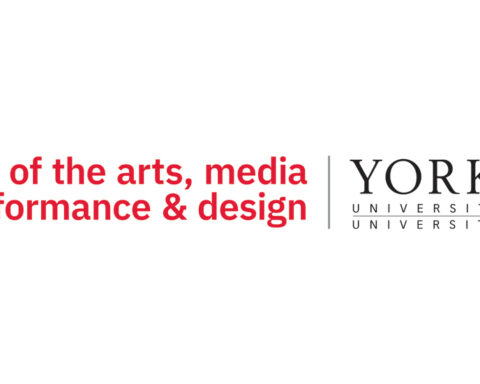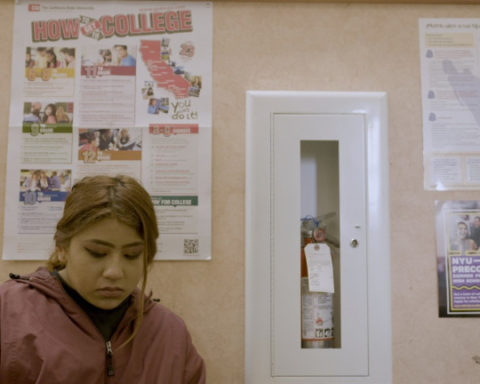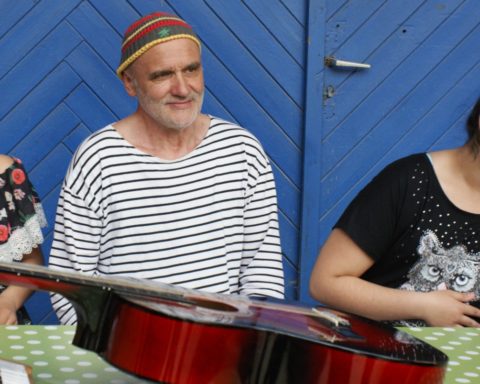UNIVERSITY OF BRITISH COLUMBIA, DEPARTMENT OF THEATRE AND FILM | VANCOUVER Four-year BFA in Film Production
Background information provided by Sarah Crauder, Film Production administrator, Department of Theatre and Film, Faculty of Arts, University of British Columbia (UBC)
LEAD ROLE: Lisa, 19, begins her BFA degree at UBC with no career in mind. On a whim, she takes an Introduction to Film Production class, which requires every student to make a short film. It’s Lisa’s favourite course. She determines to Major in Film Production, submitting her class film with her application. But, with only 15 spots available, Lisa’s first filmmaking experiment doesn’t make the cut.
ROLL CAMERA: Rejection only intensifies Lisa’s interest in film. The following year, she buys a camera and makes three shorts. She watches films by some of the university’s star grads, like Mina Shum (Double Happiness), John Pozer (The Grocer’s Wife), Bruce Sweeney (Last Wedding) and Lynn Stopkewich (Kissed), and realises that UBC is the best place for her to study the craft of filmmaking. She re-applies to the program and…is accepted.
UBC’s Film Production Major is primarily group-based, so Lisa spends a lot of time with her classmates, both in and out of school. The group takes courses in sound, cinematography and more, learning how to boom-op, set up lights and everything else it takes to make a film. Lisa and her cohorts have production meetings over lunch, crew a night-shoot set, discuss cult cinema in Film Studies class and much more.
THE CHALLENGE: Each year of the programme, all 15 students pitch a short film idea. Only the top five make the cut. If your film is selected, you direct it. If not, you choose another key role, such as DOP (director of photography) or editor. Lisa is producer/cinematographer in her first year. Her director wants to shoot on 16mm film, a whole new world for her. Since UBC encourages collaboration with other film schools, Lisa enlists students at Capilano University, who specialise in the technical aspects of film, to assist with prep and post-production. It’s a rewarding experience. In her second and final year, Lisa directs her own short film.
THE SCREENING: Lisa’s short, also shot on film, is a profound narrative about adoption, birth parents and complex family dynamics. It wins a B.C. student film award. She credits the film with giving her confidence to succeed in the industry. After the win, she tells the student newspaper: “It’s good to have a completed film like that in your arsenal, especially out there on your own in the industry, with people questioning your abilities.”
EPILOGUE: The film helps Lisa secure a position at a television production house in Vancouver. She might have stayed there, but at school, one of Lisa’s professors, the Academy Award-winning documentarian John Zaritsky, sparked her interest in non-fiction storytelling. He recommends Lisa for an intern position with a respected documentary producer. She takes the leap and learns the essentials of funding and producing a documentary feature film. Two years later, with some of her fellow students (including a TA at UBC and a Capilano grad), Lisa forms her own production company. Her first feature receives a world premiere at an international documentary film festival, major funding and distribution, and is currently playing festivals around the world. Lisa is now one of Canada’s most exciting emerging young documentary film talents.
At the University of British Columbia, students take a four-year BFA with a Major in Film Production. Students make short film and video productions, in addition to taking a broad range of film studies courses. For their theses, MFA students each make an original film.
VANCOUVER FILM SCHOOL, DEPARTMENT OF FILM PRODUCTION | VANCOUVER One-year intensive Film Production programme
Background information provided by Ted Jones, head of department, Film Production, Vancouver Film School (VFS)
LEAD ROLE: Li, 22, is an international student from Hong Kong. His parents want him to go into law. But after he wins a film award at his private school, his proud father agrees to pay the Vancouver Film School’s $32,250 tuition. Besides, the intensive programme means beloved Li will be gone for just one year.
ROLL CAMERA: (The words “First Term” appear on screen.) Immediately we see Li at work, writing, producing, and directing a four-page short film with two actors, one location and no budget. He shoots his project in the allotted 12 hours with a team of six. (“Second Term”) Li continues to take classes in the five streams of filmmaking: producing, cinematography, sound, editing and directing. He also works with a team of 12, building a complete set in one of VFS’s large new downtown studios. Here, he directs a prewritten four-page script in the allotted six hours. (“Third Term”) Li’s class focuses on episodic television. Teams create a pilot and one episode, competing for roles of director, production designer, cinematographer and editor. Li’s classmates like him: he’s diligent, creative, ambitious. He pitches to direct. A panel of instructors gives his one-minute pitch-reel thumbs up. He wins the position of director. (“Last Term”) Li embarks on his final film. Each classmate pitches his or her own script, but just one will be produced. He pitches a script he’s honed since he was a teenager. It wins! This time, though, Li bids for the role of cinematographer, his second major (after direction) at VFS.
THE CHALLENGE: Li knows few VFS final projects are feature-length, but that was his dream going into the school. Now, he realises time— just eight weeks left—and resources, won’t allow it. He reworks his script into a 15-minute short.
THE SCREENING: Li’s parents fly in for the year-end screening event, which takes place in Vancouver’s best commercial theatre. Li’s short is a time travel story, about a 1960s Russian cosmonaut, who has been stuck in orbit. He makes contact with a present-day shortwave radio operator. The spaceship makes a crash landing, and the two come together in a time warp. Aesthetically, the film is beautiful, and his two actors give exceptional performances.
EPILOGUE: After screening at two international student film festivals, the film is accepted into the Hong Kong International Film Festival. An upstart studio, looking for a television series pilot, picks it up, and hires Li (just about to apply to law school) as showrunner.
Students explore the five key disciplines of filmmaking during their year at VFS. As the year progresses, students choose to focus on two of those disciplines (including directing, cinematography, producing, production design and post-production). Each of six terms focuses on different film production projects, including documentaries, episodic shows and a final film. The result is a solid reel students will use to launch their careers as professional filmmakers.
SIMON FRASER UNIVERSITY, SCHOOL OF COMMUNICATION | BURNABY, BC Four-year BFA in Film
Background information provided by Christopher Pavsek, associate professor of Film and associate director, School for the Contemporary Arts, Simon Fraser University (SFU)
LEAD ROLE: Jack, 18, has an encyclopedic knowledge of film. He’s seen thousands of movies. And he’s made dozens of unusual films with an 8mm vintage movie camera he scored at a garage sale. A bright student, he chooses to take a film Major at SFU because he wants to earn a Bachelor’s degree, and because the film programme accepts just 25 students a year (making it one of Canada’s toughest to get into). SFU’s large, downtown campus with its diverse, artistic student body, also appeals.
ROLL CAMERA: Low light, tight shot. Jack’s rubber-gloved hands swirl in a sink. He is in a dark room, hand-developing film. Next he is in a bright studio, loading a Bolex. Cut to Jack sitting at a computer, colour-grading video at a DaVinci Resolve set-up. We see him directing actors with a RED digital cinema camera in the background. He’s in a crowded coffee shop, near school, reading a book on film theory. Then we see him asleep at his editing desk; the clock reads 3 a.m.
THE CHALLENGE: Time management. In addition to making two experimental films in first year, two dramatic shorts in second year, digital video documentaries and short films in third year, and a major grad film, Jack must cram in film theory classes, as well as history and psychology courses. It’s a pace he gets used to. In the summer, before final year even begins, he organises a crew, casts actors, and finalises his script and budget. When school begins in September, he needs to be ready to shoot the first scene of his grad project.
THE SCREENING: Films by 19 students are completed in fourth year. Diversity reigns. Jack’s friend shows an 11-minute, single-shot experimental film with no dialogue. Four films could be classified as comedies. Another half dozen are dramas. The rest are documentaries. Jack’s 15-minute film is an unusual narrative—stark, minimalist, with virtually no plot. But technically, it is perfectly executed, and features extraordinary characters in philosophical debate.
EPILOGUE: Jack’s film becomes a sensation. It screens at two Canadian festivals and is chosen as one of the Top Ten Canadian short films of the year in TIFF’s year-end survey. At his graduation party, Jack vows to work again with four classmates key to his project. During the next four years, they form a production company, and make three short films and two short documentaries. The company’s Vimeo page boasts 48 titles.
Jack still has a day job. But he has a feature-length script in the bag and when he finally produces and directs it, he will do so on his own terms.
SFU’s Bachelor of Fine Arts Film Major programme combines technical training with cinema studies and history. While most students specialise during the course of their studies, devoting themselves to screenwriting, directing, editing, etc., the programme aims to train students to become capable in all aspects of filmmaking.
EMILY CARR UNIVERSITY OF ART + DESIGN, FACULTY OF DESIGN + DYNAMIC MEDIA | VANCOUVER Four-year BFA in Film, Video + Integrated Media
Background information provided by Peg Campbell, associate professor, Film, Video + Integrated Media, Emily Carr University of Art + Design
LEAD ROLE: Sarah is 22, born in Germany and raised in Ethiopia.She wants to make art that gives back to her community. Her mother started a foundation in Ethiopia for blind mothers to raise their children together. Sarah intends to make a documentary about it.
ROLL CAMERA: Sarah aces all the required technical and theoretical courses. She learns film and video production, post-production, and innovative approaches to narrative, experimental, and documentary filmmaking. In her third year, Sarah opts to study in the field, taking online courses, while shooting her documentary of the mothers and daughters in Ethiopia.
THE CHALLENGE: Sarah needs money to purchase proper sound equipment, and while she planned to shoot the documentary herself, she realises the project requires a camera operator so that she can more fully engage with the blind mothers and their children. Emily Carr University lines up two exchange students to join her in Africa. One is a graphic design student, who builds an Indiegogo campaign to raise money for the equipment—Sarah’s film becoming Emily Carr’s first ever crowd-sourced grad project with $5,000 raised. The other exchange student is a cinematographer.
THE SCREENING: Sarah’s quietly beautiful 20-minute documentary follows a blind mother and her daughter through daily life at the foundation. You see time and again the sighted three-year-old as the eyes of her mother. Yet the mother is in charge; she scolds the child for hitting a girl. One unforgettable scene sees them doing laundry. The clothesline is tangled. The mother’s hands wave the air, and she asks, “Where is it? Where is it?” The girl is too tiny to reach it. But how do you point to a blind person? Sarah’s documentary conveys a world without vision through a visual medium remarkably well.
EPILOGUE: Three weeks after the student screening, Sarah is honoured with Emily Carr University’s highest prize, the Chancellor’s Award. The film receives a preview screening in L.A. (at an institute that sponsored its Indiegogo campaign), followed by its world premiere at the International Short Film Competition at Leipzig. Sarah attends the first screening, but not the second. She is already working on her next documentary.
At Emily Carr University, a BFA Major in Film, Video + Integrated Media combines studio work, theory and professional practice. The course aims to give students real-world experience; nine credits of the degree can be obtained through co-op placements. Graduates not only pursue careers in film and video production, but also sound art, gallery exhibition, visual communications, 3D film and animation, integrated media and interactivity.
CAPILANO UNIVERSITY, SCHOOL OF MOTION PICTURE ARTS | VANCOUVER Eight-month Documentary Certificate programme
Background information provided by Nick Kendall, coordinator & instructor, School of Motion Picture Arts, Capilano University
LEAD ROLE: Beth, 44, has pursued a range of vocations, from performance art—okay, she was a clown—to government work in Yellowknife. She decides she wants to make a difference in the world through the power of film.
ROLL CAMERA: Beth has no technical background, but she brims with story ideas. We see her inside Capilano University’s new state-of-the-art Bosa Centre for Film and Animation learning to use cameras and sound equipment while struggling with the editing software, Avid. We see her in story circles, holding students rapt. An early assignment requires telling her life story in two minutes, using still images and recorded sound. She builds a miniature set and puppets to portray her world. It’s the class’s most creative autobiography.
Near the end of the first semester, every student makes a five-minute documentary of their choice. Working in groups, they take on different roles—directing, shooting, recording sound—for each project. Beth doesn’t disappoint; by now, she can operate a camera and sound equipment. During the second half of the programme, she produces the documentary that inspired her to enroll in Capilano. She interviews a doctor, a microbiologist and a young patient, sources free online medical videos and works with the animation department. The final scene here shows a clock super-imposed on Beth at the Avid editing suite, the hour-hand circling and circling. Fade out.
THE CHALLENGE: Beth’s younger classmates seemed to have easily mastered the computer-based cameras, sound equipment and editing suites. For her, it was like learning another language—or three.
THE SCREENING: “What is your gut telling you?” No, seriously. This is the title of Beth’s 10-minute final project. It is the most entertaining film you will ever see about how gut bacteria is linked to your overall mood and well-being. It touches on stool transplants (subtitle: “The Power of Poo”); it features fascinating characters. Beth’s film covers cutting-edge medical news in a way anyone can grasp. It is everything a documentary should be. Still, in a group of films that skew to adventurer profiles—snowboarders, rock climbers, parkour artists (perhaps inspired by Capilano University’s mountain-surrounded location in North Vancouver)—Beth’s film is an anomaly.
EPILOGUE: Beth was most challenged by Avid, but she conquered the monster, as her marvelous documentary attests. She is first hired as an assistant editor on a reality television show. Then she takes a job with a cruise ship, traveling around the world as an onboard videographer. All this, while researching and gathering footage for her next documentary, no doubt another investigation of ways we can live better.
The Documentary Certificate programme at Capilano University is modeled after a professional production cycle, from story concept and development, to pre-production, production, post-production, and distribution and marketing phases. Students crew on several one-minute video production exercises as either director/editor, cinematographer or sound person, for a total of up to 18 short film credits during the eight-month programme.
BANFF CENTRE, FILM AND MEDIA PROGRAMME | BANFF, AB Six-month Media and Production practicum
Background information provided by Jenny Spurr, media and communications officer, The Banff Centre
LEAD ROLE: Jennifer, 29, has already completed a post-secondary film programme. She wants more practical experience before making the leap into the industry.
ROLL CAMERA: Jennifer finds herself working for Banff Television, a website where films, videos and short documentaries produced at the Centre can be viewed. Jennifer focuses on editing Banff Shorts—one- to three-minute, documentary-style introductions to the Centre’s diverse faculty, visiting pros and students. In a fast-paced broadcast environment, Jennifer edits profiles of opera singers, dancers, poets, cartoonists and more, and learns the power of brevity. We also see Jennifer attending talks, conferences, and performances, which have brought the Centre international renown. She loves how her artistic network expands almost every day.
THE CHALLENGE: The Banff Centre encourages everyone to think big and outside the box. Banff Shorts directors and cinematographers expect Jennifer to become comfortable editing as wide a variety of footage as they can throw at her—scenes taken with underwater cameras, drone footage, animation, CGI.
THE SCREENING: Log on to Banff Shorts to meet the artists, speakers and performers, who spent time at the Centre while Jennifer was an editor at Banff Shorts. One standout: A coral reef photographer shares his amazing story about being trapped in the feeding circle bubbles of a pod of humpback whales. The one-and-a-half minute documentary blends close-ups of the photographer sharing his adventure—simple but effective—and creative animation. It screens at the Banff Film Festival.
EPILOGUE: We see Jennifer working in a high-tech studio, editing a cutting-edge, full-body immersion, interactive film that will reinvent storytelling.
Unlike most film schools, Banff Centre’s Film & Media programme does not have classes. Instead, it offers up to 30 work-study opportunities in such disciplines as editing, cinematography and videography. Experimentation with modes of production is encouraged in the Centre’s state-of-the-art facilities.











